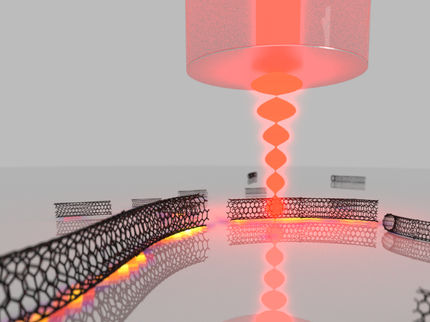Using optical fiber to generate a two-micron laser
In recent years, two-micron lasers (0.002 millimetre) have been of growing interest among researchers. In the areas of surgery and molecule detection, for example, they offer significant advantages compared to traditional, shorter-wavelength lasers. However, two-micron lasers are still in their infancy and not yet as mature as their telecom counterparts (1.55-micron). Moreover sources currently used in labs are typically bulky and expensive. Optical fibre-based 2 micron lasers are an elegant solution to these issues. This is where researchers at photonics Systems Laboratory (PHOSL) come in.
The team of Camille Brès at EPFL described a way to design these lasers at a lower cost, by changing the way optical fibres are connected to each other. Thanks to the new configuration, they were able not only to produce very good 2 micron lasers, but also to do without an expensive and complex component that is normally required.
Bloodless surgery and long-range molecule detection
Two-micron spectral domain has potential applications in medicine, environmental sciences and industry. At these wavelengths, the laser light is easily absorbed by water molecules, which are the main constituents of human tissue. In the realm of high precision surgery, they can be used to target water molecules during an operation and make incisions in very small areas of tissue without penetrating deeply. What is more, the energy from the laser causes the blood to coagulate on the wound, which prevents bleeding.
Two-micron lasers are also very useful for detecting key meteorological data over long distances through the air. Not to mention that they are highly effective in the processing of various industrial materials.
Replacing a cop with a detour
To create a 2 micron fibre-laser, light is usually injected into an optical-fibre ring containing a gain region which amplifies 2 micron light. The light circulates in the ring, passing through the gain region many times thus gaining more and more power, until becoming a laser. For optimal operation, these systems include a costly component called isolator, which forces the light to circulate in a single direction.
At PHOSL, researchers built a thulium-doped fibre laser that works without an isolator. Their idea was to connect the fibres differently, to steer light instead of stopping it. "We plug a kind of deviation that redirects the light heading in the wrong direction, putting it back on track", said Camille Brès. This means no more need for the isolator, whose job is to stop light moving in the wrong direction, sort of like a traffic cop. "We replaced the traffic cop with a detour," said Svyatoslav Kharitonov, the article's lead author.
Higher quality laser
The new system not only proved to be less expensive than more traditional ones, it also showed it could generate a higher quality laser light. The explanation is as follows: the laser output gets purified because light interacts with itself in a very special way, thanks to the amplifying fibre's composition and dimensions, and the high power circulating in this atypical laser architecture. "While the association of amplifying fibres and high power usually weakens traditional lasers performance, it actually improves the quality of this laser, thanks to our specific architecture", said Svyatoslav Kharitonov.
Original publication

Get the analytics and lab tech industry in your inbox
By submitting this form you agree that LUMITOS AG will send you the newsletter(s) selected above by email. Your data will not be passed on to third parties. Your data will be stored and processed in accordance with our data protection regulations. LUMITOS may contact you by email for the purpose of advertising or market and opinion surveys. You can revoke your consent at any time without giving reasons to LUMITOS AG, Ernst-Augustin-Str. 2, 12489 Berlin, Germany or by e-mail at revoke@lumitos.com with effect for the future. In addition, each email contains a link to unsubscribe from the corresponding newsletter.























































